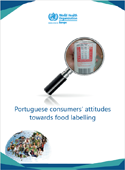Portuguese consumers’ attitudes towards food labelling (2017)

Download
Policy-makers, researchers, food manufacturers and retailers are re-examining the provision of nutrition information to consumers on food labels. The WHO Regional Office for Europe has called on countries to extend the use of consumer-friendly front-of-package (FOP) labelling that is easy to understand and interpret on the basis of strong, consistent evidence that such schemes are preferred and correctly understood. Challenges in implementing policies at national level have been experienced, however, because governments and policy-makers lack knowledge about consumers’ attitudes and behaviour in regard to food choice and consumption. In some setting, it has therefore been difficult to identify the most appropriate scheme. In the Portuguese context, little was previously known about consumers’ attitudes towards food labelling. There was some evidence of differences between consumers who are poorly and highly literate and also according to gender, age and socioeconomic status; however, there were no unequivocal data on how different consumer segments understand and respond to nutrition labelling.
Consumers read labels for several reasons: to obtain information about a product (e.g. its contents, production process, origin, certification), to compare different brands and when purchasing a new product. Often, consumers expect that they will reinforce previously learnt information. Recently, because of food safety scandals and the increasing popularity of health- and environment-conscious consumption patterns, consumers are interested in making better-informed decisions and healthy food choices by reading the information on product packaging (e.g. nutrition labels, environment labels, warning labels and health claims) (Dörney & Gyulavári, 2016). Thus, it is clearly important to provide appropriate, understandable nutrition information to consumers, and it can have a significant positive effect on food choice (Wills et al., 2009).
The aim of this report is to show how Portuguese consumers use and understand nutrition information on food labels in their daily lives. It starts by presenting the theoretical framework for exploring the research goals. This is followed by a description of the methods, including the overall research approach, data collection techniques and data analysis procedures. Primary data were collected in a survey of 1127 Portuguese consumers and in four focus groups that explored differences among adults who were strongly conscious about healthy eating, adults who were weakly conscious about healthy eating, adults with less education and young people aged 15–18 years.
A first important insight of this study is the importance in investigations of using mixed methods to gain deeper understanding of consumers’ attitudes towards nutrition labelling. The qualitative approach allowed us to further characterize consumers’ preferences for labels and to identify obstacles to their use, which may be useful in future intervention strategies.
In a national survey (A.C. Nielsen, 2012), Portuguese consumers reported that they often used food and nutrition labelling to make choices, especially at the point of sale. The results of the focus groups discussions, however, indicated that actual use of food labels, and especially nutrition labels, in food purchase is lower. This study shows that they consider the best location for information about nutrients in food to be the front of the package. Consistent with much international evidence, all segments of Portuguese consumers preferred symbolic, coloured schemes and simple, FOP presentation of key nutrients. According to the results of the focus groups, the “traffic light” scheme is best understood by all groups and can result in faster decision-making at points of sale. The report ends with some recommendations for the main stakeholders on real use of nutrition labels.
This report adds knowledge about Portuguese consumers’ understanding, preferences and use of different labelling formats. It makes a valuable contribution to policy discussions on FOP labelling and may inform decisions on a national scheme. Internationally, the study adds to the growing consensus that FOP labelling is important to consumers and that the most effective schemes are likely to be those that are interpretive and based on symbols, colours, words or quantifiable elements.



